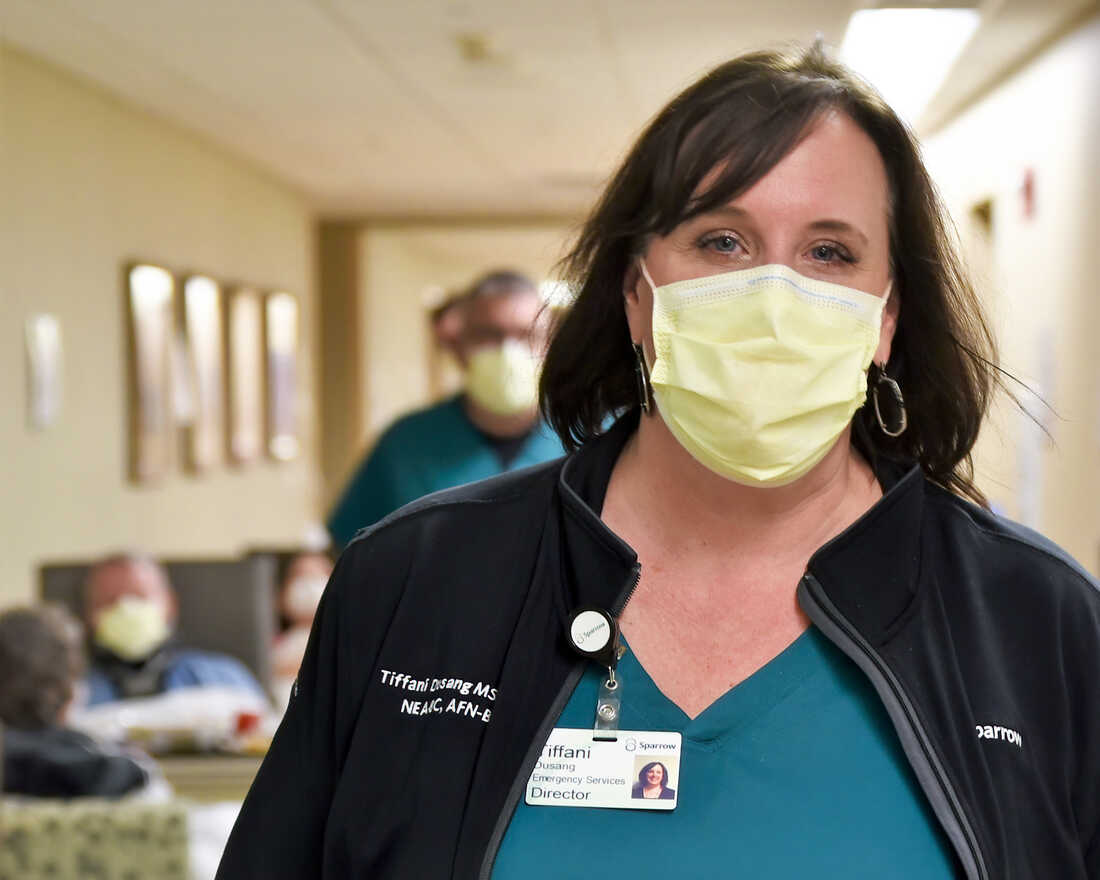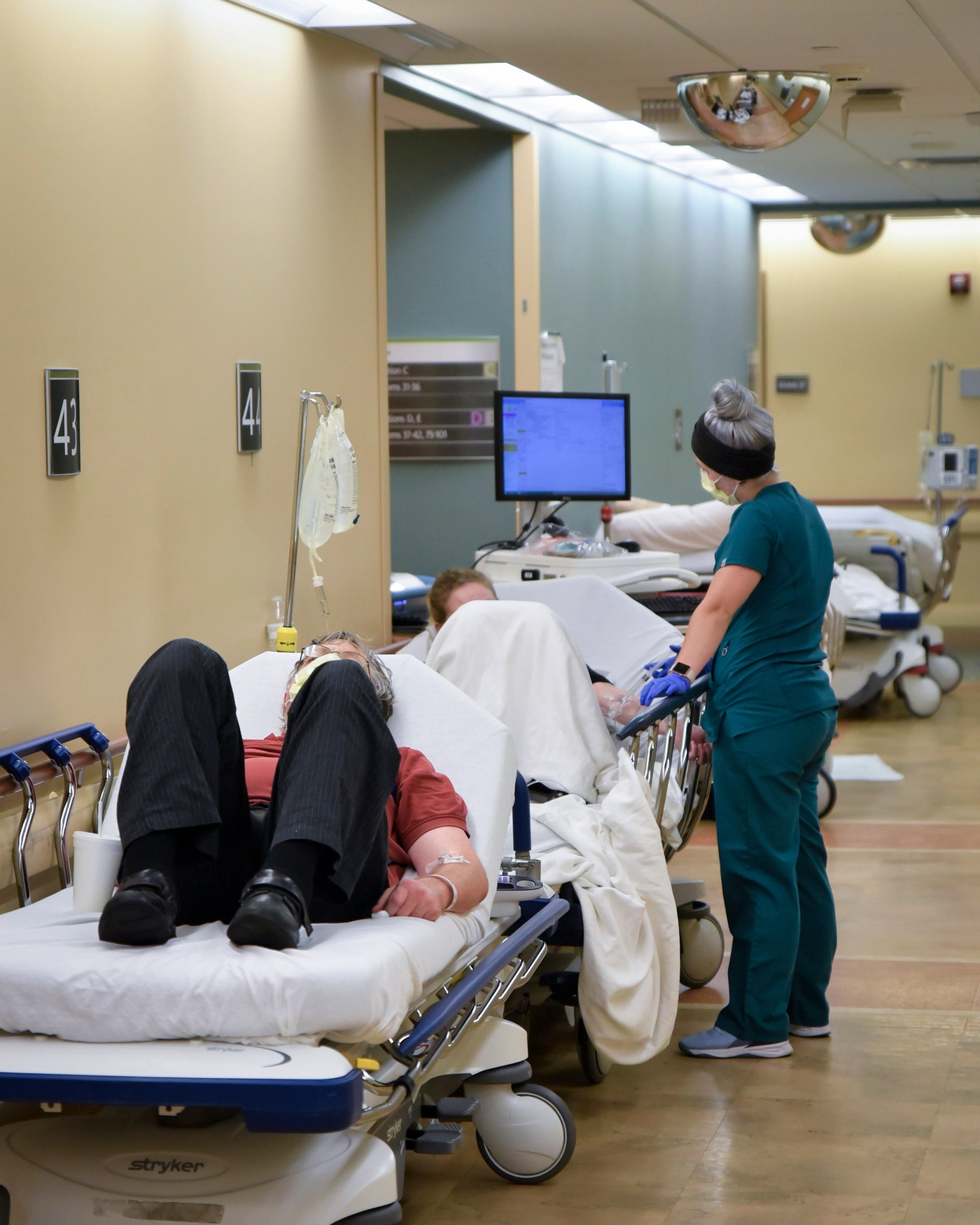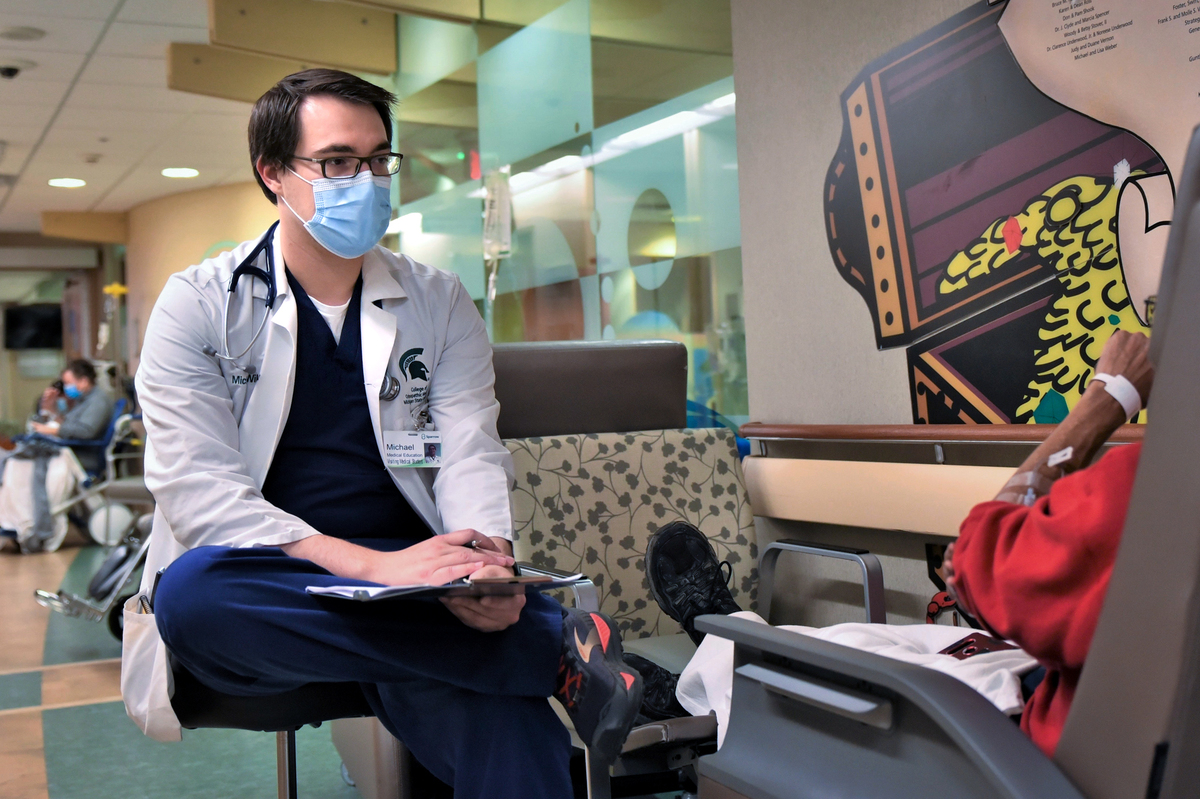Im Not Allowed at Urgent Care Again Meme

An ambulance crew weaves a gurney through the halls of Sparrow Hospital's emergency department in Lansing, Michigan. Overcrowding has forced the staff to triage patients, putting some in the waiting rooms and treating others on stretchers and chairs in the halls. Lester Graham/Michigan Radio hide caption
toggle caption
Lester Graham/Michigan Radio

An ambulance crew weaves a gurney through the halls of Sparrow Hospital's emergency department in Lansing, Michigan. Overcrowding has forced the staff to triage patients, putting some in the waiting rooms and treating others on stretchers and chairs in the halls.
Lester Graham/Michigan Radio
Inside the emergency department at Sparrow Infirmary in Lansing, Mich., staff members are struggling to intendance for patients who are showing up much sicker than they've ever seen.
Tiffani Dusang, the emergency room's nursing director, practically vibrates with pent-up anxiety, looking at all the patients lying on a long line of stretchers pushed up confronting the beige walls of the infirmary's hallways. "It's hard to watch," she says in her warm Texan twang.
Merely there's nothing she tin can do. The ER'due south 72 rooms are already filled.
"I ever experience very, very bad when I walk downwardly the hallway and run across that people are in pain or needing to sleep or needing quiet. But they have to exist in the hallway with, every bit y'all can see, ten or 15 people walking by every minute."
It's a stark contrast to where this emergency department — and thousands others — were at the starting time of the coronavirus pandemic. Except for initial hot spots like New York Urban center, many ERs beyond the U.S. were oftentimes eerily empty in the bound of 2020. Terrified of contracting COVID-nineteen, people who were sick with other things did their all-time to stay away from hospitals. Visits to emergency departments dropped to half their normal levels, co-ordinate to the Epic Health Research Network, and didn't fully rebound until the summer of 2021.
But at present, they're too full. Even in parts of the country where COVID-nineteen isn't overwhelming the health system, patients are showing up to the ER sicker than they were before the pandemic, their diseases more advanced and in need of more complicated care.
Months of treatment delays have exacerbated chronic weather and worsened symptoms. Doctors and nurses say the severity of affliction ranges widely and includes intestinal pain, respiratory problems, blood clots, middle conditions and suicide attempts, amid others.

Tiffani Dusang is the director of emergency and forensic nursing at Sparrow Infirmary. As overworked nurses leave, she struggles to staff every shift and works difficult to go on remaining nurses from burning out. Lester Graham/Michigan Radio hide explanation
toggle caption
Lester Graham/Michigan Radio

Tiffani Dusang is the manager of emergency and forensic nursing at Sparrow Hospital. As overworked nurses get out, she struggles to staff every shift and works difficult to keep remaining nurses from burning out.
Lester Graham/Michigan Radio
But there'south nowhere to put them all. Emergency departments are ideally meant to be cursory ports in a storm, with patients staying just long enough to exist sent domicile with instructions to follow up with their primary intendance dr. or being sufficiently stabilized to exist transferred "upstairs" to inpatient units or the intensive intendance unit.
Except now, those long-term intendance floors are full too, with a mix of COVID-19 and non-COVID-nineteen patients. That means people coming to the ER are being warehoused for hours, even days, forcing ER staff to perform long-term care roles they weren't trained to do.
At Sparrow, space is a valuable commodity in the ER: A carve up section of the hospital was turned into an overflow unit. Stretchers stack up in halls. The hospital has even brought in a row of dark-brown reclining chairs, lined upwardly confronting a wall, for patients who aren't sick enough for a stretcher but are likewise ill to stay in the main waiting room. However, some of the patients in the dark-brown recliners are hooked up to IVs, while others talk quietly with medical specialists who sit down across from them holding clipboards, perched on wheeled stools.
There is no privacy, as Alejos Perrientoz just learned. He came to the ER this detail morning because his arm has been tingling and painful for over a week now. He can no longer hold a loving cup of java. A nurse gave him a total physical exam in the brown recliner, which made him self-witting about having his shirt lifted up in front of strangers. "I felt a lilliputian uncomfortable," he whispers. "But I have no option, you know? I'g in the hallway. There's no rooms."
"Nosotros could accept done the concrete in the parking lot," he adds, managing a express mirth.
On the other side of the ER, beyond a warren of identical-looking hallways and heavy double doors that tin be opened only with an employee badge, is Sparrow's ambulance bay. Seventy to 100 ambulances pull in each 24-hour interval. "It's a lot," Dusang says, watching emergency medical service teams wheel their patients over to the triage nurse. "It's the highest I've ever seen in my career."
About iii times a week, the ER arrives at a point where it simply tin can't take any more than patients, she explains. Then it sends out the alarm for ambulances to divert patients to other hospitals. Simply that's a risky move because Sparrow is ane of the only hospitals in this part of the state that's equipped to handle astringent traumas. Dusang says information technology feels like "waving the white flag."
"But you have to do information technology when you lot feel unsafe," she says, significant so crowded that the staff tin can't provide patients with adequate care. "And then although it won't [entirely] continue ambulances from coming in, at least it gives them that sensation that, 'Oh, you know, the ED's in trouble.' "
Even patients who arrive by ambulance are non guaranteed a room: One nurse is running triage hither, screening for those who absolutely need a bed and those who can be put in the waiting expanse.
"I hate that we fifty-fifty have to make that determination," Dusang says. Lately they've been pulling out some of the patients who are already in the ER's rooms, when others go far who are even more critically sick. "No i likes to take someone out of the privacy of their room and say, 'We're going to put you in a hallway considering we demand to go intendance to someone else.' "
The number of ER patients is mostly back to normal, simply patients are so much sicker
This isn't just happening at Sparrow.
"We are hearing from members in every part of the country," says Dr. Lisa Moreno, president of the American Academy of Emergency Medicine (AAEM). "The Midwest, the South, the Northeast, the Westward ... they are seeing this verbal same phenomenon."
Although the number of ER visits returned to pre-coronavirus levels this past summertime, access rates, from the ER to the hospital's inpatient floors, are still near 20% higher. That's according to the most recent analysis by the Epic Health Research Network, which pulls information from more than 120 million patients across the land.
"It'south an early indicator that what's happening in the ED is that nosotros're seeing more than astute cases than nosotros were pre-pandemic," says Caleb Cox, a data scientist at Epic.

A nurse talks to a patient on a stretcher in the hallway of the emergency section at Sparrow Hospital. Lester Graham/Michigan Radio hibernate caption
toggle caption
Lester Graham/Michigan Radio

A nurse talks to a patient on a stretcher in the hallway of the emergency section at Sparrow Hospital.
Lester Graham/Michigan Radio
Less acute cases, such every bit people suffering from wellness issues like rashes or conjunctivitis, still aren't going to the ER as much every bit they used to. Instead, they may be opting for an urgent care center or their master intendance doctor, Cox explains. Meanwhile, in that location has been an increase in people coming to the ER with more than serious conditions, like strokes and center attacks.
"Fifty-fifty though nosotros're seeing the overall volumes come up dorsum to normal over the summer here, we see that the more than acute conditions even so remain higher than the pre-pandemic normals, while the lower-acuity conditions all the same remain below pre-pandemic normals," Cox says. So fifty-fifty though the total number of patients coming to ERs is about the same as before the pandemic, "that'south absolutely going to feel like [if I'm an ER doctor or nurse] I'm seeing more patients and I'm seeing more than acute patients."
How overwhelmed ERs can affect patient care
Moreno, the AAEM's president, works at an emergency section in New Orleans. She says the level of illness, as well as the inability to admit patients speedily and move them to beds upstairs, has created a level of anarchy in the ER that she describes equally "non even humane."
At the beginning of a recent shift, she heard a patient crying nearby and went to investigate. It was a man with paraplegia who'd recently had surgery for colon cancer. His large mail service-operative wound was sealed with a device called a wound vac, which pulls fluid from the wound into a drainage tube attached to a portable vacuum pump.
Merely the wound vac had malfunctioned, and that's why he had come to the ER. But staffers were so busy that by the time Moreno came in, the fluid from his wound was leaking everywhere.
"When I went in, the bed was covered," she recalls. "I mean, he was lying in a puddle of secretions from this wound. And he was crying, because he said to me, 'I'm paralyzed — I can't move to get away from all these secretions, and I know I'thou going to finish upwardly getting an infection. I know I'chiliad going to end up getting an ulcer. I've been laying in this for like 8 or nine hours.' "
The nurse in charge of his care told Moreno she just hadn't had time to assistance this patient yet. "She said, 'I've had and so many patients to take care of, and so many critical patients. I started a [Iv] baste on this person. This person is on a cardiac monitor. I just didn't have time to get in in that location.' "
"This is non humane intendance," Moreno says. "This is horrible intendance."
But it'southward what tin can happen when emergency department staffers don't take the resources they need to bargain with the onslaught of competing demands.
"All the nurses and doctors had the highest level of intent to practise the correct affair for the person," Moreno says. "Only because of the loftier vigil of ... a big number of patients, the staffing ratio of nurse to patient, even the staffing ratio of physician to patient, this guy did not get the care that he deserved to get, just as a man."
This unintended neglect is extreme and not the experience of the vast majority of patients who arrive at ERs right now. But the problem is non new: Even before the pandemic, ER overcrowding had been a "widespread problem and a source of patient harm ... reflective of not just individual department performance or even individual infirmary operation, but of health system dysfunction throughout the Us," according to a recent commentary in NEJM Catalyst Innovations in Intendance Commitment.
"ED crowding is not an issue of inconvenience," the authors wrote. "There is incontrovertible evidence that ED crowding leads to significant patient harm, including morbidity and mortality related to consequential delays of treatment for both high- and low-acuity patients."
And information technology'due south called-for out an already overwhelmed staff.
Burnout feeds staffing shortages, and vice versa, in a roughshod bike
Every morning, Dusang wakes upwards and checks her Sparrow email with one singular hope: that she volition non see nevertheless another nurse resignation letter in her inbox.
"I cannot tell you how many of them [the nurses] tell me they went home crying" after their shifts, she says. "And you only hope they show up the next day for more."
But despite Dusang's best efforts to support her staffers, check on them regularly, talk with them near their careers and make them feel seen, heard and appreciated, she cannot stop them from quitting. And they're leaving also fast to replace, either to take higher-paying gigs as travel nurses, to try a less-stressful type of nursing or to only walk away from the profession entirely.
Midway through the afternoon shift at Sparrow, a nurse breaks downwardly sobbing. A fellow nurse, Amy Harvey, pulls her into a corner and reminds her to have deep breaths.
"Everybody has a breaking signal," Harvey says. "It just depends on the day and the state of affairs ... mine could exist in three days. Something comes in that just hits home for some reason, and I need a minute to go take a deep breath."

A student from the College of Osteopathic Medicine at Michigan State Academy consults with a patient in the hallway of Sparrow Hospital's ER. Lester Graham/Michigan Radio hide caption
toggle caption
Lester Graham/Michigan Radio

A student from the College of Osteopathic Medicine at Michigan State University consults with a patient in the hallway of Sparrow Hospital's ER.
Lester Graham/Michigan Radio
To assistance fill the staffing gaps, Sparrow's ER has hired about 20 "babe nurses," a term for brand-new nurses. To bring them on lath, the hospital waived its previous requirement for working in the ER — at least 1 yr of nursing experience elsewhere — and many of these new nurses are fresh out of nursing school. Correct abroad, they've begun their careers by diving into the deep stop, even though they're still training.
"I need some assistance," ane of these new nurses whispers to her supervisor, holding up an IV pocketbook. She tin't get the pinnacle open up. "It just pushes in, doesn't it?"
The veteran nurse takes information technology and shows her: "You gotta twist it so those line up," she says. With a blatant simply grateful "Thaaaank youuuu!" the baby nurse turns and peels off toward the patient's room.
Kelly Spitz has been an emergency department nurse at Sparrow for 10 years. But lately, she has besides fantasized well-nigh leaving. "Information technology has crossed my listen several times," she says, however she continues to come up back. "Because I accept a team here. And I love what I exercise," she says, but then starts to cry. It's not the hard work or even the stress. Information technology's non being able to give her patients the kind of intendance and attention that she wants to give them and that they demand and deserve.
She still thinks a lot about a particular patient who came in a while ago. His test results revealed last cancer. Spitz spent all mean solar day working the phones, hustling case managers, trying to get hospice care set in the human'due south home. He was going to die, and she just didn't want him to have to die here, in the hospital, where only ane visitor was even allowed. She wanted to get him domicile and back with his family.
"I was willing to take him dwelling house in my own auto, because we were waiting and waiting and waiting for an ambulance, considering they're not available," Spitz said. Finally, after many hours, they constitute an ambulance to take him home.
Three days subsequently, the man's family members chosen Spitz: He had died, equally she expected. Only he had died surrounded by family. They were calling to give thanks her.
"I felt like I did my task there, because I got him domicile," she says. Just that'southward a rare feeling these days. "I just hope it gets better. I promise it gets better shortly."
At 4 p.m., the emergency section is the busiest it has been all twenty-four hours. The patients waiting in the halls seem peculiarly vulnerable, silently witnessing the controlled chaos rushing by them. Ane woman is sleeping or unconscious on a stretcher, naked from the waist down. Someone has thrown a sail over her, so she's partially covered, but role of her hips and legs are blank, and open up sores are visible on her calves.
As one shift approaches its end, Dusang faces a new crunch: The overnight shift is fifty-fifty more curt staffed than usual.
"Tin can nosotros get two inpatient nurses?" she asks, hoping to borrow two nurses from ane of the hospital floors upstairs.
"Already tried," replies nurse Troy Latunski.
Without more staff, it'southward going to be hard to care for new patients who come in overnight — from car crashes, seizures or other emergencies.
Merely Latunski has a plan: He'll become home now, snatch a few hours of sleep and return at 11 p.m. to work the overnight shift in the ER's overflow unit. That means he will be largely caring for eight patients solitary, on just a few brusk hours of sleep. Just right now, that is their only, and best, option.
Dusang considers for a moment, takes a deep breath and nods. "OK," she says.
"Go habitation. Get some slumber. Thank you," she adds, shooting Latunski a grateful grin. And then she pivots, because another nurse is already approaching her with an urgent question. It's on to the side by side crisis.
Source: https://www.npr.org/sections/health-shots/2021/10/26/1046432435/ers-are-now-swamped-with-seriously-ill-patients-but-most-dont-even-have-covid

0 Response to "Im Not Allowed at Urgent Care Again Meme"
Post a Comment